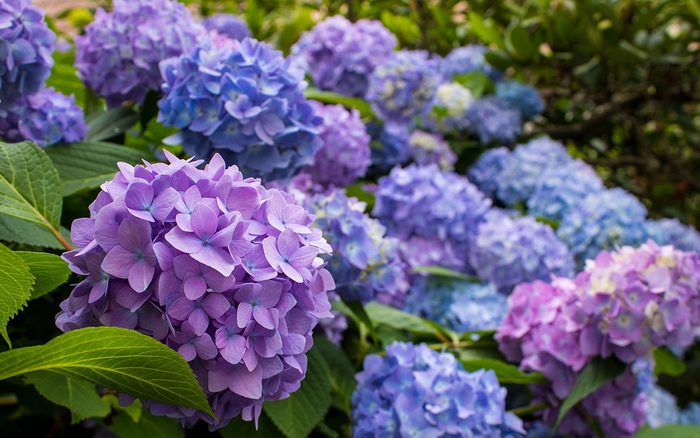How to Care for Hydrangeas: 7 Things You Need to Know
Updated: Jun. 07, 2023

Here's a closer look at how to care for hydrangeas, including tips on where and how to plant them.
Hydrangeas add gorgeous flowers and dimension to your garden and landscape. The perennials have stunning foliage and blooms, and are mostly fuss-free. Plus, the blooms look absolutely beautiful in a vase!
Learn how to care for hydrangeas with these helpful garden hints.
Choose the right one
The huge variety of sizes and blooms is what makes hydrangeas so appealing. For plush pink or blue flowers, look for macrophylla varieties, also called lacecap or mophead. Paniculata types are larger with conical flowers, great for mixed borders or hedges. The foliage of Oakleaf hydrangeas have brilliant color in the fall. For perennial vines that reach impressive heights, choose climbing hydrangeas. Check out 6 breathtaking hydrangea species you need in your garden—and learn which hydrangea is right for you.
Find the best location
Hydrangeas can be tiny or huge! Dwarf varieties like ‘Paraplu’ are perfect for containers, while large ‘Kyushu’ hydrangeas are better for your landscape. Choose your hydrangea keeping both the height and spread of the mature plant in mind.
Check out 6 hydrangea facts that even expert gardeners don’t know.
Give them sun—and shade
Hydrangeas like partial sun, ideally full sun in the morning, then shade from the hot afternoon rays. The lacecap and mophead hydrangeas are especially susceptible to wilting. However, some varieties can handle more sun, especially in northern areas. Try these easy-to-grow plants to add color to your shade garden.
Get your soil ready
Hydrangeas like fertile, well-drained soil. You can improve soil with compost and other organic matter to add nutrients. If you add fertilizer, do so only a couple of times in the growing season—too much will mean fewer flowers. Only the macrophylla hydrangeas change color based on soil acidity. Here’s how to change the color of your hydrangeas.
Plant the right way
Plant your hydrangea in spring after the danger of frost has passed. Dig a hole as deep as the root ball and 2-3 times as wide. Gently loosen the roots, then plant using plenty of rich soil. Give the hydrangea a thorough soaking at the base daily for the first week while the plant gets established.
Provide plenty of water
Hydrangeas should get a deep watering about three times a week. Water them at their roots, and ideally in the morning—the afternoon heat takes a toll on plants.
No flowers? This may be why
If your hydrangeas don’t have many blooms, there are a few possible reasons. You may be over-fertilizing: two to three applications during a season is usually plenty. Another culprit is damage from frost. Hydrangeas that bloom on last season’s growth (old wood) will need a layer of straw or mulch to protect the stems through winter.
Pruning may also be to blame—hydrangeas need only light pruning to remove diseased or dead branches. Don’t prune away stems that will bloom. Follow these steps to prune hydrangeas correctly.
Next: The ‘Wee Bit Giddy’ hydrangea is the GORGEOUS flower missing from your garden.




















